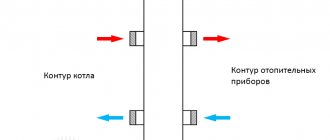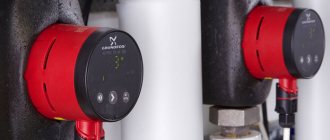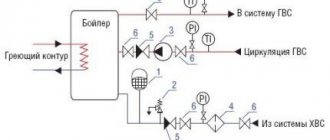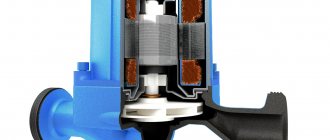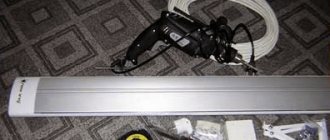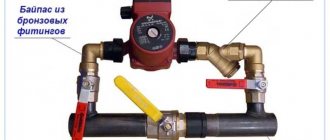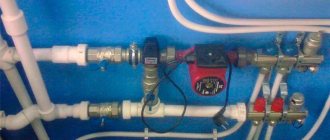Author: Alexander Starchenko
Autonomous heating systems can operate without a circulation pump, or may have one or more such devices. The circulation pump ensures the normal movement of coolant through the pipes of the heating system and prevents it from stagnating.
If the mains voltage is cut off as a result of an accident or for another reason, turning off the pump in winter can jeopardize the functionality of the entire heating system and even lead to a serious accident. Based on this, an uninterruptible power supply for the heating circulation pump must be a mandatory part of the system.
- Determining the required UPS power
Choosing a UPS for a heating circulation pump

In volatile systems, pumping equipment is installed directly into the boiler. Therefore, when choosing a UPS for a heating circulation pump, the parameters specified in the technical documentation of the water heating equipment are taken into account. For non-volatile systems, the pump is installed separately.
Connecting an uninterruptible power supply ensures the performance and stability of the heating heat transfer.
Precautions and possible errors
- First of all, if you decide to make an uninterruptible power supply for a heating pump with your own hands, you need to wear gloves so as not to receive an electric shock from exposed wires or contacts.
- You should carefully examine the wires - they should not have even slight damage, because... A short circuit is very dangerous and can not only harm human health, but also cause a fire.
- For the system, you should connect several batteries (it is best to take 2-4 fully charged ones) and connect them in parallel.
- In no case should you save money and buy cheaper devices, since the quality and service life usually correspond to the price.
- Do not connect everything to the device; use it exactly for those devices for which it is designed for its power. However, for computers, as a rule, this power is quite enough, the main thing is that the total power does not exceed the maximum permissible.
- The best choice, as experts advise, would be models with phase-dependent equipment.
Uninterruptible power supply for circulation pump
The electronic device is a small box with a battery. The latter is not always built-in, depending on the manufacturer . In this case, it is prepared separately and then attached.
The purpose of the UPS is to accumulate charge in order to give it to the connected device when the need arises. The main components of each UPS:
- Battery or connector for connecting it . Fulfills the sole purpose of a UPS—storing and using backup power.
- The converter changes the current from DC to AC, also affecting the voltage.
- The filter serves to technically clean the network - stabilize and eliminate interference.
- A stabilizer is necessary to bring the system into a balanced state.
Reference! Some devices have a built-in UPS system for remote control and charge control.
The uninterruptible power supply for the circulation pump must have a sinusoidal output voltage. If the shape is any other shape, the engine will have a hard time running, which will deteriorate it over time and lead to replacement. Small deviations are acceptable, especially when the device is turned on rarely.
How to make an uninterruptible power supply with your own hands
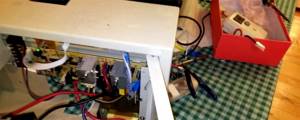
It is quite possible to create an uninterruptible power supply yourself, but this requires theoretical knowledge. If you are not comfortable with electricity, then it is better not to take risks and not to endanger the heating system. Plus, a device created by yourself will not be ideal in terms of appearance, and will not work automatically, but using manual control.
To assemble the UPS, you will need:
- Converter 12 to 220 Volt. Inverters differ in their characteristics - you will need a device with an operating power of 300 W, and a peak power of 600 W.
- Batteries. It is best to stick with helium batteries; they are more expensive, but also last much longer.
- Battery charger. The power must correspond to the battery capacity.
Connect the plus and minus of the inverter with a wire to the plus and minus of the battery. Plug the boiler into the power supply at the inverter; after switching on, the device will start operating from the UPS. When the battery is discharged or the power is turned on, connect the charger to the battery.
It is important to understand not only how to make a UPS , but also how to ensure its reliable operation.
When assembling a homemade uninterruptible power supply, the following points should be taken into account:
- Use thick copper wires for connections.
- The wires should not come loose anywhere: carefully check that they are securely connected to the devices. The check must be repeated from time to time: if the metal in these places oxidizes, the reliability of the connection may suffer.
- Do not use car batteries.
- When batteries are connected in series, the voltage increases, but the capacity does not change.
- With a parallel connection, the capacitance increases, but the voltage remains the same.
- The minimum battery capacity for a UPS is 100 A/h, although on the Internet you can find uninterruptible power supply schemes using batteries of lower capacity.
Uninterruptible power supply for heating system
Backup uninterruptible power supplies for the circulation pump operate autonomously (this means that the battery does not turn on until the power is turned off). This uninterruptible power supply for a heating pump is very popular among summer residents and cottage owners. Autonomous heating systems can operate without a circulation pump, or may have one or more such devices.
The use of circulating heating systems goes back many decades. The pump, by circulating hot water through the heating pipes, prevents stagnation of the coolant. If there is a power outage in the network for various reasons, turning off the pump in winter can jeopardize the functioning of the entire heating system and even lead to an emergency.

In this regard, an uninterruptible power supply for the circulation pump must be part of the heating system. The ability to adjust for low or high voltage conditions makes this uninterruptible power supply for circulation pump dominant in the power range of 0.5-5 kVA.
For information. Which UPS is the safest? Like any product, an uninterruptible power supply depends on the production process and the quality of materials. This can vary greatly from one manufacturer to another. Once you have found a brand that you are happy with, it is recommended that you use products from that brand. Confidence in your uninterruptible power supply is critical.
Choice
The first thing to consider when choosing an uninterruptible power supply:
- Circulation pump power.
- Its energy consumption class.
- The time for which the lights are turned off.
Why do you need to know the energy consumption class? Let's say we have a 45 W pump. At the moment of startup, a power surge occurs, i.e. it will consume more watts. It is important that it does not exceed the capacity of the UPS. If you have a class A pump, the frequency converter reduces the starting torque to 1.5 times the normal power. Then the maximum power indicator will be 45x1.5=67 W.
If you do not know the energy consumption class of the pump, it is better to play it safe and take a factor of 6. Then the calculation will look like this: 45x6 = 270 W.
The operating time of the UPS will depend on the number and capacity of the batteries. However, increasing the number of batteries is not cheap and not all uninterruptible power supplies allow the use of additional battery packs.
UPSs with built-in batteries are used mostly to mitigate power surges - transforming their sawtooth shape into a smooth sine wave. In case of shutdown, they can ensure the operation of the boiler only for 20 minutes.
Another option is a UPS with a charger to which you can connect external batteries.
Battery life is calculated as follows:
(Battery capacity) x (per circuit voltage) : (total power in VA)
Note: To convert the total power from W to VA, it must be divided by 0.7.
8-12 hours of battery life is a good indicator for a UPS. And for batteries, the optimal capacity is 100A/h.
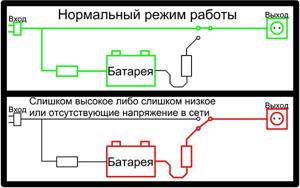
Scheme of UPS operation using Offline technology
Line-interactive or Online UPS to choose?
If the boiler is gas or diesel, On-Line devices are better suited. You can also use Linear Interactive, but additionally install a voltage stabilizer to it.
For solid fuel boilers, you can choose a cheaper linear-interactive UPS.
Mistakes that are often made when choosing a UPS:
- The battery life is determined not by the power of the device, but by the capacity of the batteries.
- If the marking contains the LT index, this means that the UPS comes with external batteries, which are not included in the price of the unit. You need to buy them additionally - without them the device will not work.
- The numbers indicated in the model are not W, but VA.
- Refrain from purchasing UPS from dubious manufacturers.
Manufacturers that have proven themselves to be reliable are Fiamm, Leoch, Delta, AQQU, CSB, Inel.
Gas heating remains popular due to the low cost of fuel. However, installing a chimney for a gas boiler requires knowledge and certain experience, since the installation requirements are very strict due to the increased risk of explosion. Read about what types of chimneys exist and how to install them. Read about what vapor-drip heaters are and where they are used in this article.
Approximate prices
There are various models on the UPS market for all types of wallets.
A linear-interactive UPS for heating can be purchased for 5800 – 9400 rubles.
The On-Line series model will cost from 12,300 rubles. There are units for 20, 33, 75 and 100 thousand rubles.
As already mentioned, batteries are not included with the UPS - they must be purchased separately.
Depending on the model and capacity, one battery can be purchased for 2300-11000 rubles.
Purchasing and installing a UPS may seem like a waste of time and money. However, there is a possibility of losing expensive equipment and being left without heating during the cold season. And if you weigh all the pros and cons, the costs of uninterruptible power supply no longer seem so great.
Double conversion uninterruptible power supply
Those equipment that have increased requirements for power quality require an uninterruptible power supply with double conversion. Using an inverse converter, the device converts alternating current into direct current and vice versa. If the voltage suddenly disappears, then there is no need to switch to batteries, since they are always included in the circuit. The device usually says that the switching time is zero. But to some extent this is true information, since there is no switching, which means no time is wasted.
The double conversion uninterruptible power supply adjusts the frequency and voltage and produces a perfect sine wave. Such devices create noise, generate heat and are quite expensive.
Types of UPS
The uninterruptible power supply, depending on the supported options, performs the following functions:
- automatic switching to power from a rechargeable battery (AB) in emergency situations;
- inverting DC voltage (12 V) into the required alternating voltage (220 V) with frequency adjustment of 50 Hz;
- smoothing out voltage surges and filtering network noise lasting 10–100 ms;
- stabilization of the “transit” network voltage in normal mode.
Connecting to a computer
How to connect a UPS to a computer? To connect the UPS to the network, you must use the power cable included in the kit. Once connected, the battery will begin charging. When connecting equipment, you must turn off the UPS and computer. Connecting the uninterruptible power supply to the computer must be done after disconnecting the UPS and all components in the circuit. Then all that remains is to connect the computer to the appropriate socket. In addition to the computer, you can also connect peripherals to the UPS. If the design provides for the possibility of communication lines, then they should also be connected immediately.
It is worth remembering that the output connectors are not equivalent, so connecting the UPS to the computer should be done with this in mind. For example, in the Eaton 9130 model they are divided into 2 groups. The first is connected to an important load, which provides power to the equipment during a power outage. The second group is connected to non-critical loads, for example, audio output devices. Power supply to the load belonging to the first group will have priority.
Popular factory models
The following UPS models are considered the best sellers:

- Energy PN-1000. The battery capacity is 75 Ah, which is enough for continuous operation of the boiler for 8 hours. At the output, the device produces a smooth sinusoid. It has a linear-interactive appearance, has an affordable price and increased efficiency. The average cost of the model is 26,000 rubles. Other types of devices are offered, differing in battery capacities.
- SVC DI-600-F-LCD. A small device can support the operation of boilers and pumping stations. The output voltage has no pronounced deviations. The equipment does not require regular maintenance. The speed of transition to offline mode is 15-20 microseconds. Built-in battery is not included. External batteries with a capacity of up to 200 Ah are used. This ensures 24 hours of continuous pump operation. The maximum load should not be more than 360 W. This UPS model will cost 6-7 thousand rubles.
- Tieber T-1000. An uninterruptible power supply with the largest capacity allows the heating system to operate for at least 48 hours during a power outage. The device is powered by 2 batteries with a capacity of 200 Ah. It is recommended to install gel batteries that do not emit toxic fumes. The device can withstand peak loads of up to 800 W. The output voltage is a pure sine wave. The UPS can power the boiler, pump and underfloor heating system.
If there are frequent power outages, it is not recommended to save on purchasing an emergency power supply device.
Advantages of uninterruptible power supplies for powering circulation pumps
It is not difficult to imagine what unpleasant consequences freezing water in the system in winter will lead to. Replacing burst pipes and radiators alone will cost owners a pretty penny.
Parametric failures in the electrical network can damage boiler electronics. This is a voltage drop to 160–170 V (in single-phase units) during peak periods of energy consumption, amplitude surges and deviations of alternating current with a frequency of 50 Hz.
The design of a UPS or UPS (Uninterruptible Power Supply) is a device with a battery and a DC-AC converter (direct current → alternating current). The process of inverting the uninterruptible power supply is controlled by a microcontroller with a quartz oscillator.
What distinguishes UPS from other alternative sources is:
- compactness of the devices , which allows the production of products in tabletop/floor-standing versions;
- ease of connection and operation, quiet operation of the entire model line of uninterruptible power supplies;
- the relative cheapness of most product items;
- basic protection of the electric motor and electronics of the autonomous hot water system;
- no maintenance costs during use;
- long service life (with battery recharging): from 3–5 years or more;
- minimal time pause or lack thereof when switching “backup power ↔ network”;
- almost sinusoidal output voltage with minimal distortion;
- the ability to change the frequency and voltage of the connected load.
Common UPS Problems

Problematic uninterruptible power supply board
When using the device to ensure uninterrupted power supply to a heating boiler, the following problems may arise:
- Contamination of the surface of the uninterruptible power supply, dust settling, which can lead to improper operation of the device (this problem often occurs if the device is installed in a room where construction work is being carried out).
- If the power supply frequently experiences voltage surges, the inverter may fail.
- After many years of use, rechargeable batteries become damaged (they charge slowly or do not charge at all, and quickly lose their charge).
- The grease on cooling fans requires constant replacement. Over time, it hardens and causes the cooling system to malfunction, eventually causing the UPS to completely fail.
Price
- “Energy Technologies”;
- N-Power;
- Eaton;
- Inelt.
The price of the equipment consists of the cost of the UPS itself (on average - 15 - 22 thousand rubles) + battery(s) of the quantity and capacity that were calculated by the consumer for his circumstances. AGM with a capacity of 26 Ah costs about 3 thousand rubles, and 200 Ah costs about 20 thousand rubles.
The total cost of an average set is 25 - 30 thousand rubles.
Conclusion
Connecting a UPS to the heating system will not only provide reliable insurance against freezing in the middle of winter due to a power failure. The uninterruptible power supply will also extend the life of the circulation pump and boiler, since it will produce the highest quality current.
Forced circulation in a heating system is more efficient than gravitational circulation. A circulation pump for heating systems is an indispensable device in a modern heating system.
We will tell you how a heat pump works for heating a house in this article. Let's give an example of calculating a heat pump.
Correct phasing is necessary for correct power supply of the heating boiler
Many modern gas heating boilers are phase-dependent; to power such heating boilers, it is necessary to strictly observe the phasing when connecting. Phasing is necessary for the correct operation of the flame sensor of a heating boiler; the ionization current of such a sensor flows from the “phase” to the “ground”. If such a boiler is not connected correctly, combustion will not occur. The computer UPS does not produce a signal with a pronounced phase. For this reason, it is impossible to use a computer uninterruptible power supply to power a modern gas boiler.
Several pumps and a boiler
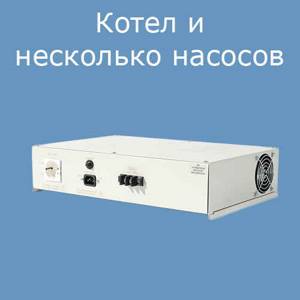
When the heating system has a gas boiler and several pumps, or a boiler with high electricity consumption, such as a pellet or automatic coal boiler, is installed, a more powerful uninterruptible power supply is needed. Uninterruptible power supplies “Teplocom 600” and “Teplocom 1000” are capable of providing backup power to loads of 450 W and 800 W, respectively.
The price of the Teplocom 600 UPS is 16,800 rubles.
The price of the Teplocom 1000 UPS is 24,500 rubles.
